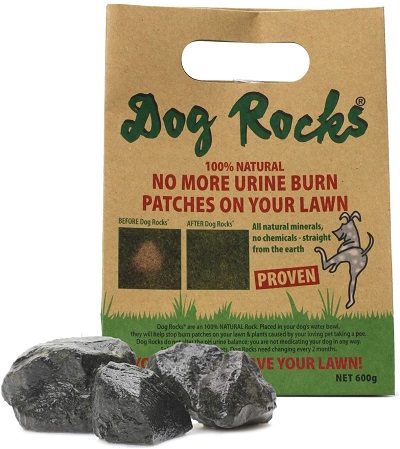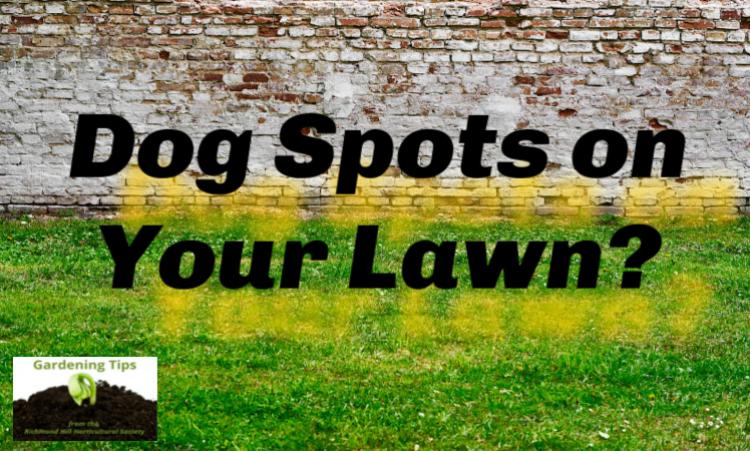Submitted by Debbie Coleman and Doreen Coyne, members of the Richmond Hill Garden & Horticultural Society
If your backyard has become your dog’s potty place then you likely have lots of yellow or brown spots in it. This is both annoying but also doesn’t let your yard look BBQ nor party ready! One colleague ended up replacing her lawn due to this issue.
Why does the lawn turn yellow or brown?
Dogs instinctually do their business in the same area each time, and repeated exposure to dog urine kills the grass. Dog’s urine is naturally slightly acidic (6 to 6.5). However, the dry kibble most dogs eat alters the pH of their urine, causing it to become alkaline. This shift in pH is one reason why dog urine can cause brown spots in your yard. Another contributing factor is that dog urine contains a lot of nitrogen, which fertilizes plants in small amounts. However, in large or concentrated amounts, excess nitrogen chemically burns plants including grass turning them yellow or brown.
This is why it’s not uncommon to find yellowish-brown dog urine spots ringed by lush, green grass: the grass that got hit directly with urine died, while the grass that only received a little exposure got fertilized. Salts and trace minerals from dog urine can also build up in the soil over time, contributing to dead spots.
How to fix the problem. There are several ideas which you can read below but if you do more than one, you can multiply their effectiveness.
1. A new way to stop the PH effect from your dog’s urine. DOG ROCKS is a relatively new product and is available at TruPet, Pet Value, PetSmart, and Amazon. I’ve included a photo so you know what you are looking for.

Dog Rocks are made from naturally occurring paramagnetic igneous rock mined in Australia, and provide a 100% natural solution to urine burn patches on the lawn, shrubs, and box hedge. Dog Rocks do not affect the pH balance of your dog's urine and are safe for all household pets. Rather, Dog Rocks work like a sponge, absorbing excess nitrates and other trace elements from your dog’s water that causes urine to burn the grass. You just place 200 grams of Dog Rocks into a half-gallon of water, then use that to fill your pet’s water bowl. They’ve been laboratory tested and are safe for your pets. Within 3-5 weeks, you should start to notice a change in your lawn’s appearance and new urine patches should not appear. If they do, verify that your pet’s water bowl is their primary source of water! This is being used with great success by our member Debbie.
2. Change your dog’s diet. Dogs are naturally carnivores, and their bodies are designed to subsist primarily on meat which makes their urine acidic. But if the pH is normal, dog urine will fertilize the lawn and shouldn’t cause any problems. However, if a dog is fed a diet with more grains or carbohydrates (found in many brands of dry dog food), the pH balance shifts and the urine becomes alkaline which will harm your grass.
Feeding your dog a diet of fresh or canned food and reducing or eliminating dry dog food with potatoes, grains, or other carbohydrates should ensure their urine is more acidic and less likely to cause burn spots.
3. Dilute the nitrogen. Spray water on the dog’s special potty areas. By washing down the lawn after your dog does her business, you will dilute the nitrogen and salts in the urine, preserving the life of your lawn.
4. Train Your Dog to use one specific spot! Although it does take some time and effort, dogs can be trained to do their business in a specific part of the yard, away from the grass. Another dog-loving friend, made a special area in an in-ground planter edged with 6x6s just for his dog. The dog loved it as it had some nice plants in it providing him with some shade and a little privacy.
5. Take your dog for a walk every time he needs to use the facilities. At least it keeps him away from the yard more and it could help improve your fitness level as well.
6. Increase your dog’s water intake. By encouraging your dog to drink more water, you can dilute the potency of the nitrogen in the urine. This will make the pee less damaging to your grass. It won’t stop the brownish-yellow spots but can help if used in conjunction with some of the other methods mentioned.
7. If you get desperate you could install a dog run (or even an entire yard) with artificial grass. Same attractive appearance as grass but is not affected by dog urine. This allows you to let the dog out to run or play or just to get fresh air – all within an area in which he can’t ruin real grass! My friend used this with suggestion three after a few years making his designated dog potty area stain resistant. By the way, nowadays artificial grass or turf has a 100% permeable backing allowing the urine to pass through into the soil so no concern re puddling unless you are putting it over an area of clay soil that already has puddling issues.








